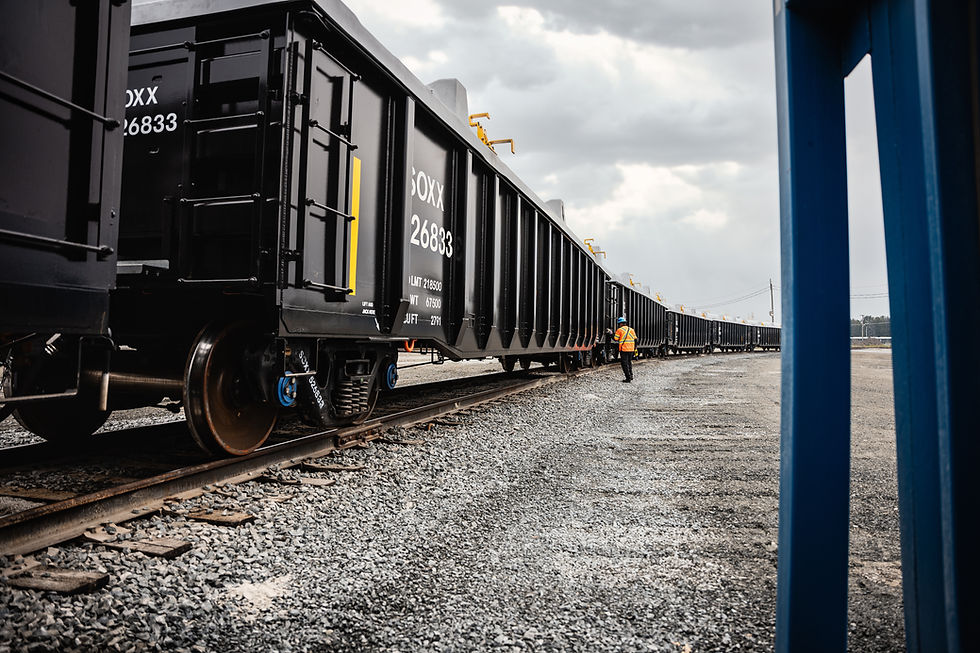Track Integrity: How Rail Car Covers Protect Shear Strength Of Rail Ballast
- Solurail

- 16 déc. 2024
- 3 min de lecture
First of all, What is Shear Strength?
Shear strength is a material's ability to resist shear forces, which are forces that cause one part of the material to slide relative to another. In engineering, it is a critical property for aggregates like Rail Ballast and is partially influenced by:
Cohesion: The internal bonding between particles.
Frictional Resistance: The resistance due to the interlocking of particles.
Applied Normal Stress: The perpendicular force pressing particles together, which increase friction.
Shear Strength in Rail Ballast
Shear strength is essential for maintaining the track's integrity and preventing lateral and vertical movement under train loads.
Factors Affecting Shear Strength in Ballast
Aggregate Interlocking: The sharp edges of ballast stones interlock to resist movement.
Moisture Content: Excessive water reduces shear strength by decreasing interlocking (friction) and bonding (cohesion) of the particles.
Contamination: Materials like coal dust, mud, or debris fill the voids between ballast stones, reducing friction and drainage, which weakens shear strength.

How Low Shear Strength Causes Derailments
Loss of Track Stability:
Ballast with low shear strength fails to hold the track in its proper alignment.
This can lead to lateral or vertical movement of the track under dynamic train loads, known as track deformation.
Compromised Load Distribution:
Reduced shear strength disrupts the even distribution of train loads to the subgrade. This causes stress concentrations, leading to subsidence or uneven track settlement.
Poor Drainage:
Fouled ballast retains water, reducing its shear strength further and leading to track instability during wet conditions.
Lateral Forces During Train Movement:
Trains, especially at curves, exert lateral forces on the track. Low shear strength in the ballast makes it unable to resist these forces, increasing the risk of track buckling and derailments.

Track Buckling - (Source at the end)
Is there any studies on it?
A study conducted by Tutumluer et al. (2008) examines how coal dust fouling impacts the shear strength and performance of rail ballast. Through laboratory testing, the researchers demonstrate that as coal dust infiltrates clean ballast, it fills the voids between aggregate particles, reducing interlocking and frictional resistance. The study demonstrate that Coal Dust has a 91% High Liquid Limit and a 41% Plasticity Index. Combine with a Optimum Moisture Content (OMC) of 35%, which higlighted the ability to hold a greater amount of moisture than most silty and clayey soils.
Key findings include:
Shear Strength Reduction: Ballast with coal dust contamination shows a steady decline in shear strength, particularly when wet. Fully fouled ballast exhibits shear properties similar to coal dust alone, emphasizing a loss of structural stability.
Impact of Moisture: Wet coal dust reduces the ballast’s ability to drain water, creating a paste-like consistency that further compromises strength and stability.
Track Instability: Fouled ballast fails to adequately resist vertical and lateral forces from train loads, increasing the risk of track deformation and derailments.
Ready to keep Your Rail Operations Safe?
Protecting the track integrity is crucial for a safe rail operation. Coal Dust Fouling on the Rail Ballast has been proven to affect it's Shear Strenght, which can lead to a weaker track integrity and ultimately to derailments. A good way to prevent those fouling is to adopt the Rail Car Covers Solutions in order to reduce the risk of accident, maintenance costs and environmental and social impacts. In this article we focus on the importance of Track Integrity (Safety) but we don't undermine the environmental and social impact that a contamination could generate.

Contact us today to learn more or request a quote:
Phone: 819-874-RAIL
Email: info@solurail.com
Website: www.railcarcovers.com
Transform your rail operations with innovative solutions that deliver measurable results. Let’s move forward—together.
Source of Track Buckling: Datei:Gleisverwerfung ehem Bf Gütersloh Ost 04 08 2013.jpg


Commentaires